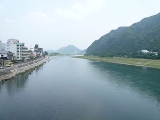
Battle of Nagaragawa
Encyclopedia
The was a battle that took place along the banks of the Nagara River
in Mino Province
in April 1556. (The site of the battle is in present-day Gifu
, Gifu Prefecture
, Japan
.) It was a battle between Saitō Dōsan
and his son, Saitō Yoshitatsu
.
and ruled over Mino Province
as such. He had originally planned on passing his power onto Yoshitatsu, but in 1555, he started thinking of passing it on to one of his other sons, Kiheiji (喜平次).
at the time, heard of his father's plans and, in 1556, killed his two brothers in the family residence on Mount Inaba
, starting the intrafamily skirmish. Yoshitatsu was able to gain the support of a large portion of the family's soldiers, gathering approximately 17,500 men. Dōsan, on the other hand, was only able to amass around 2,700 soldiers.
Yoshitatsu handily won the battle, which ended in Dōsan's death. Oda Nobunaga
had sent in troops to support Dōsan, but they did not reach the battle in time to offer any help.
Nagara River
The has its source in the city of Gujō, Gifu Prefecture, and its mouth in the city of Kuwana, Mie Prefecture, Japan. Along with the Kiso River and Ibi River, the Nagara River is one of the Kiso Three Rivers of the Nōbi Plain. Previously, the river was named Sunomata River . With a length of , it...
in Mino Province
Mino Province
, one of the old provinces of Japan, encompassed part of modern-day Gifu Prefecture. It was sometimes called . Mino Province bordered Echizen, Hida, Ise, Mikawa, Ōmi, Owari, and Shinano Provinces....
in April 1556. (The site of the battle is in present-day Gifu
Gifu, Gifu
is a city located in the south-central portion of Gifu Prefecture, Japan, and serves as the prefectural capital. The city has played an important role in Japan's history because of its location in the middle of the country. During the Sengoku period, various warlords, including Oda Nobunaga, used...
, Gifu Prefecture
Gifu Prefecture
is a prefecture located in the Chūbu region of central Japan. Its capital is the city of Gifu.Located in the center of Japan, it has long played an important part as the crossroads of Japan, connecting the east to the west through such routes as the Nakasendō...
, Japan
Japan
Japan is an island nation in East Asia. Located in the Pacific Ocean, it lies to the east of the Sea of Japan, China, North Korea, South Korea and Russia, stretching from the Sea of Okhotsk in the north to the East China Sea and Taiwan in the south...
.) It was a battle between Saitō Dōsan
Saito Dosan
was a daimyo who dramatically rose and also fell from power in Sengoku period Japan. He was also known as the for his ruthless tactics.-Life:Originally a wealthy merchant from Yamashiro Province , he entered the service of Nagai Nagahiro of Mino Province , assuming the name Nishimura Kankurô.He...
and his son, Saitō Yoshitatsu
Saito Yoshitatsu
was a Japanese daimyo of the Sengoku period. He was the second generation lord of the Saitō clan.-Early life:Yoshiatsu was born in Mino Province in 1527, the eldest son of Saitō Dōsan. Some theorize that Yoshitatsu was in fact the son of Toki Yorinari, the former ruler of Mino...
.
Background
In 1542, Dōsan became the representative of the Toki clanToki clan
The was a powerful clan that ruled in Japan from the Kamakura period to the Edo period. It descended from Emperor Seiwa by Minamoto no Yorimitsu from the Minamoto clan and used Toki in Mino Province as their hometown...
and ruled over Mino Province
Mino Province
, one of the old provinces of Japan, encompassed part of modern-day Gifu Prefecture. It was sometimes called . Mino Province bordered Echizen, Hida, Ise, Mikawa, Ōmi, Owari, and Shinano Provinces....
as such. He had originally planned on passing his power onto Yoshitatsu, but in 1555, he started thinking of passing it on to one of his other sons, Kiheiji (喜平次).
Battle
Yoshitatsu, who was living in Sagiyama CastleSagiyama Castle
was a castle built in Mino Province in Japan during the late-Heian period ; it was destroyed during the Sengoku period in the mid 16th century. The castle's ruins are located in the present-day city of Gifu, Gifu Prefecture. It stood at the peak of Mount Sagi, which was only...
at the time, heard of his father's plans and, in 1556, killed his two brothers in the family residence on Mount Inaba
Mount Kinka (Gifu)
, also known as Kinkazan, is located in the heart of the city of Gifu, Gifu Prefecture, Japan, and rises to a height of . Previously called Mt. Inaba , it has long served as the representative symbol of Gifu. It stands along the Nagara River, creating bountiful nature within the city...
, starting the intrafamily skirmish. Yoshitatsu was able to gain the support of a large portion of the family's soldiers, gathering approximately 17,500 men. Dōsan, on the other hand, was only able to amass around 2,700 soldiers.
Yoshitatsu handily won the battle, which ended in Dōsan's death. Oda Nobunaga
Oda Nobunaga
was the initiator of the unification of Japan under the shogunate in the late 16th century, which ruled Japan until the Meiji Restoration in 1868. He was also a major daimyo during the Sengoku period of Japanese history. His opus was continued, completed and finalized by his successors Toyotomi...
had sent in troops to support Dōsan, but they did not reach the battle in time to offer any help.

